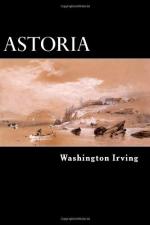From Point Vancouver the river turned towards the northeast, and became more contracted and rapid, with occasional islands and frequent sand-banks. These islands are furnished with a number of ponds, and at certain seasons abound with swans, geese, brandts, cranes, gulls, plover, and other wild-fowl. The shores, too, are low and closely wooded, with such an undergrowth of vines and rushes as to be almost impassable.
About thirty miles above Point Vancouver the mountains again approach on both sides of the river, which is bordered by stupendous precipices, covered with the fir and the white cedar, and enlivened occasionally by beautiful cascades leaping from a great height, and sending up wreaths of vapor. One of these precipices, or cliffs, is curiously worn by time and weather so as to have the appearance of a ruined fortress, with towers and battlements, beetling high above the river, while two small cascades, one hundred and fifty feet in height, pitch down from the fissures of the rocks.
The turbulence and rapidity of the current continually augmenting as they advanced, gave the voyagers intimation that they were approaching the great obstructions of the river, and at length they arrived at Strawberry Island, so called by Lewis and Clarke, which lies at the foot of the first rapid. As this part of the Columbia will be repeatedly mentioned in the course of this work, being the scene of some of its incidents, we shall give a general description of it in this place.
The falls or rapids of the Columbia are situated about one hundred and eighty miles above the mouth of the river. The first is a perpendicular cascade of twenty feet, after which there is a swift descent for a mile, between islands of hard black rock, to another pitch of eight feet divided by two rocks. About two and a half miles below this the river expands into a wide basin, seemingly dammed up by a perpendicular ridge of black rock. A current, however, sets diagonally to the left of this rocky barrier, where there is a chasm forty-five yards in width. Through this the whole body of the river roars along, swelling and whirling and boiling for some distance in the wildest confusion. Through this tremendous channel the intrepid explorers of the river, Lewis and Clarke, passed in their boats; the danger being, not from the rocks, but from the great surges and whirlpools.
At the distance of a mile and a half from the foot of this narrow channel is a rapid, formed by two rocky islands; and two miles beyond is a second great fall, over a ledge of rocks twenty feet high, extending nearly from shore to shore. The river is again compressed into a channel from fifty to a hundred feet wide, worn through a rough bed of hard black rock, along which it boils and roars with great fury for the distance of three miles. This is called “The Long Narrows.”
Here is the great fishing place of the Columbia. In the spring of the year, when the water is high, the salmon ascend the river in incredible numbers. As they pass through this narrow strait, the Indians, standing on the rocks, or on the end of wooden stages projecting from the banks, scoop them up with small nets distended on hoops and attached to long handles, and cast them on the shore.




